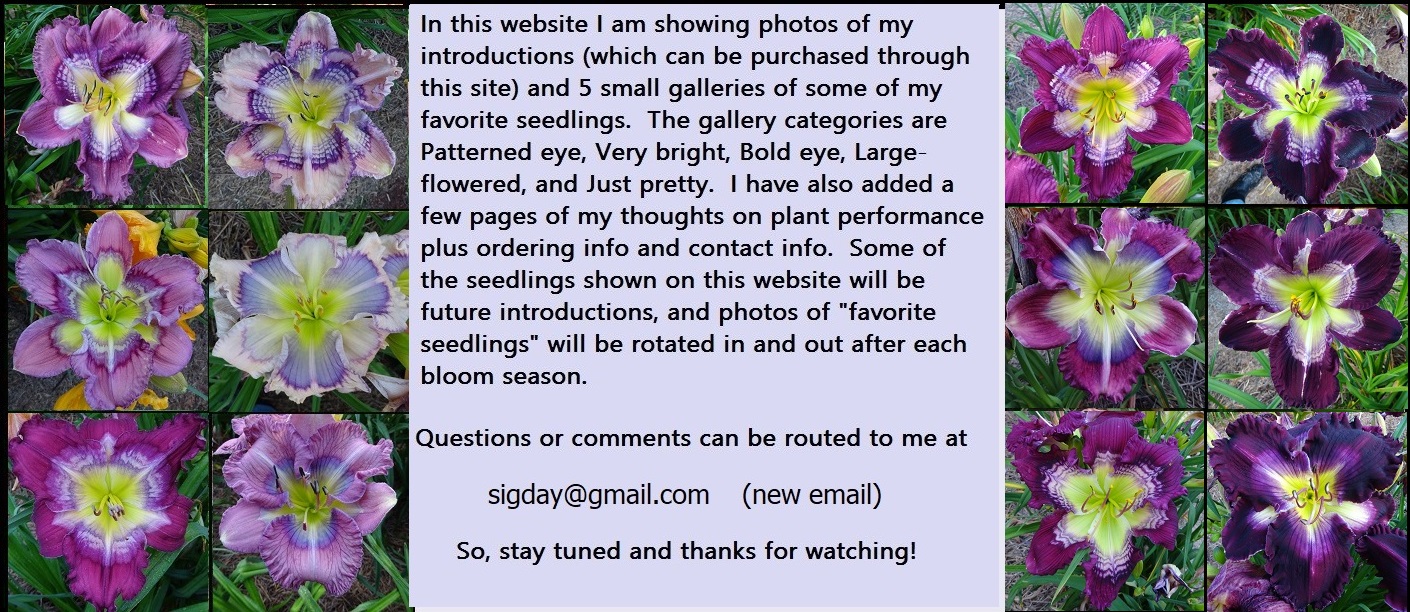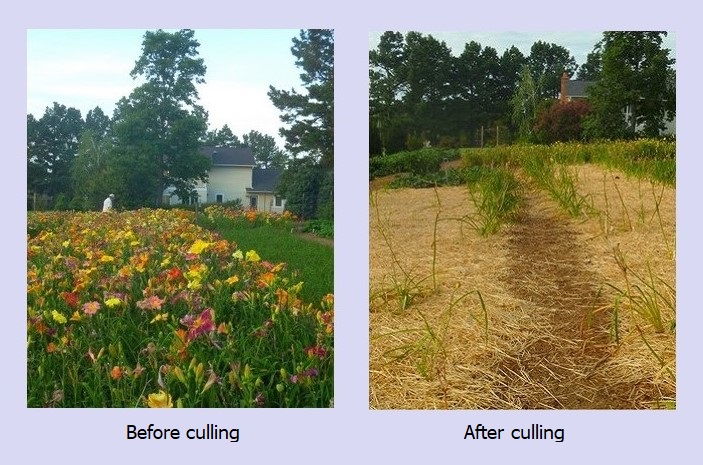


The photos in the collection shown above are some of the most exciting new faces in my hybridizing program. They are just shown as a matter of general interest, as most have not been evaluated yet and some may not be suitable for commerce.
The following listings on this website are my introductions to date. I have hybridized with certain plants of my diploids that showed the best resistance to rust during the year 2000 onslaught of daylily rust. Very few of the tetraploids that I grew showed any resistance to rust at all, so I discontinued working with tets altogether.
The faces of my flowers are similar to the photos of flowers shown by other hybridizers. Genes for eye patterns, bright colors, large flowers, etc., are widely distributed across the country. However, I have narrowed my line of selected seedlings to those which will perform well under adverse growing conditions, primarily rust infestation conditions and hot summer sun exposure. I have favored dormant foliage also because most dormant daylilies can perform better after our single digit winters. So, while these daylily introductions have not reached overall perfection, another hybridizer may benefit from adding some toughness to his/her best seedlings by crossing them with my best of a similar type. After all, tinkering with imperfect crosses to hit the jackpot seedling is what hybridizing is all about, in my opinion.
I spent a number of years doing line-breeding only with my daylilies. Until 2015, I did not introduce or sell any, and I developed descriptions of plant performance for my own use. I was aiming for large flat full-formed flowers and I have not deviated from that style in my hybridizing. However, no matter how much I like the bloom, the plants have had to tolerate rust exposure and intense sun exposure and still perform well in order to avoid being culled. I illustrate my culling percentages with the photo shown below.

From 2000 on, rust resistance became an important part of my hybridizing, and the increasingly hot summers have required attention to sun resistance also. I developed codes for descriptions of plant performance that I still use on my plant tags and captions on the photos in this website. I am showing these terms below to clarify what rust resistant and sun resistant traits are displayed by each cultivar shown.
RUST RESISTANCE: RR – Rust resistant. Has never shown rust in this garden. However, with multiple strains of rust in the U.S. (identified in 2015) the plant may not be resistant to all strains of daylily rust.
VHR – Very high resistance to rust. Very high resistance reflects that over the period of the plant’s life, only one or two pustules have been discovered, and some years, none at all.
HR – High resistance to rust. Cultivars in this class can exhibit a few pustules throughout the season or may show pustules only toward the end of the season, when the foliage is in decline. The presence of only one rust pustule on the foliage throws a plant from rust resistant into the high resistance category.
MR – Moderate resistance to rust. Numerous pustules, but not enough to damage plant health or performance. The rust generally occurs during or after the bloom cycle.
PR – Poor resistance to rust. Plant is covered with rust pustules, and the degree of rust infestation varies from year to year. Some of these plants are able to bloom reasonably well in spite of the rust. Some seasons, they may not show any rust at all, but the potential for severe rust exists within the plant.
SUN RESISTANCE: Day-long exposure to full summer sun, 85 degrees F to 95 degrees F, will cause many daylilies to melt, brown, or wilt. Daylilies here are evaluated for sun resistance at 7 p.m. or later, and I describe the condition of the flower as follows:
Outstanding – the outstanding category is reserved for flowers whose color and form has changed very little, even at temperatures 95 degrees F – 100 degrees F. Few blooms can show sun resistance after 100 degrees F but a few can do so, and are so noted.
Excellent – Examples of the excellent category of flowers remain in relatively good condition throughout the day and into the evening with very minor changes in substance and color.
Good – The good category is for flowers that show some fading and/or a hint of discoloration. The overall garden appearance of the flower is still good into the early evening (7:00 p.m.) hours.
Using these performance clues, I can make crosses with plants with strong performance in sun or rust resistance with weaker ones, to obtain better plant performance with faces that are still charming in the garden. It’s a slow process, but I have noted that every year brings overall improvement, so the record-keeping time seems to be worth it. I think most hybridizers keep similar records, and hope that the reputation of the daylily will be enhanced with so many working to improve the flower for us all.